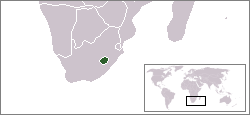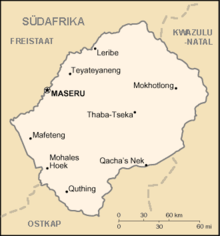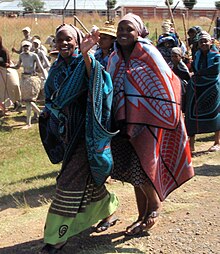| location | |
 | |
| flag | |
 | |
| Short dates | |
| Capital | Maseru |
|---|---|
| Form of government | Constitutional monarchy |
| currency | Loti (LSL) |
| surface | 30,355 km² |
| population | about 2 million |
| languages | English |
| Religions | Christians 80%, traditional religions 20% |
| Phone code | 266 |
| Internet TLD | .ls |
| Time zone | CET 1h |
Lesotho is a perfect of South Africa enclosed landlocked country.
Cities


- Maseru - Capital
Other goals

As part of the Maloti-Drakensberg Park, the mountains in the border region are part of the world natural heritage.
- In the Maloti Mountains (in South Africa Drakensberg called) one finds:
- in the Mahlasela Valley is the small ski area Afriski. With five planned lifts, it should be the largest ski area in Africa. Currently the few ski tourists come almost exclusively from South Africa, the ski season runs from June 1st to September 1st. There are 320 beds of various categories from Backpacker- Dormitory (2018: 170 LSL in summer, 310 LSL in winter) to chalet (605 or 1155 LSL p.P.).
- those lying on average over 2400 m high 1 Sehlabathebe National Park(29 ° 53 ′ 56 ″ S29 ° 7 ′ 16 ″ E). There are those Heritage Lodge, opened in 2015, to which a campsite at the former Jonathan's Lodge belongs. More accommodations in the villages outside the park. The wild and romantic landscape and fauna, especially Cape and Bearded Vultures, are worth seeing.
- The only piece of forest in Lesotho is located in the Butha-Buthe District at an altitude of 2600 m 2 Ts'ehlanyane National Park(29 ° 0 ′ 0 ″ S28 ° 25 ′ 0 ″ E), Entry 40 LSL 10 per car. Shared taxis are available from Butha-Buthe. Ts'ehlanyane is the local name for the mountain bamboo Thamnocalamus tessellatus. Roe deer and eland occur, as well as rodents Myotomys sloggetti (“Ice rat”). Good hiking trails are marked. Guides can be recruited at the entrance. You should allow 2-3 days for the 39 km long path to the Bogong Reserve. The Maliba Lodge offers accommodation in the upper price range.
- The one that has been damming the Malibamat's downstream since 1996 3 Katse dam(29 ° 20 ′ 13 ″ S28 ° 30 ′ 22 ″ E) has created a beautiful lake, the water masses of which press on the rock in such a way that seismic activity occurs. However, the project, co-financed by the financial interests of the Washington World Bank with South Africa, has improved the electricity supply, which is always precarious in Lesotho. The living conditions of the indigenous peasants displaced in exchange for compensation have deteriorated in the barren land.[1] The 4 Katse Botanical Garden(29 ° 20 ′ 3 ″ S28 ° 28 ′ 54 ″ E) was set up to protect plant species endangered by damming (e.g. Aloe polyphylla) and to set up a collection of seeds for traditional medicinal plants.
- The 5 Bokong Nature Reserve(29 ° 4 ′ 9 ″ S28 ° 25 ′ 34 ″ E) is a protected area in the headwaters of Bokong and Lepaqoa. The best known is the Lepaqoa waterfall, which regularly freezes to a block in winter. In the vicinity there are two stone round huts where you can stay overnight, otherwise you have to camp. The visitor's center is about 1½ km below the Mafika Lisiu pass (3090 m) on the tarred A25.
- At the locality of Nazareth (Maseru Ditrict) in the west of the country is 6 Ha Baroana(29 ° 21 ′ 46 ″ S27 ° 47 '24 "E.) with ancient rock carvings. The last 7 km go over rough slopes.
- Kome cave dwellings (Ha Kome Caves).
background

The settlement area of the dominant in Lesotho BasothoTribe was made by the Dutch Voortrekker increasingly restricted. King Moshoeshoe I began to alliance with the British Cape Colony in 1843, at the same time he created a tribal federation with a center around Butha-Buthe. Although the western territories were lost in the war in 1858, it was possible to remain free from the Boer republics as Basutoland in 1868-70 and by placing it under British protection in 1884. Young men in particular hired themselves out as guest workers in the mines around Johannesburg. The first elections in 1965 were followed by independence a year later.
Chief Jonathan ruled autocratically from 1970-86, was then eliminated by a coup led by Justin Lekhanya, after which the exiled King Moshoeshoe II († 1996) became head of state again. As in all black African states, there was a phase of political instability after independence, with timely military intervention from South Africa preventing the massacres that are common elsewhere in the 1990s. From 2007 to 2012 there was again political unrest.
Compared to the surrounding South Africa, Lesotho is poorer, but also often more original, although many traditions have been lost due to labor migration in the last century.
Hikes are ideal in the rural mountain regions. Guided tours, some on resistant ones Besotho-Ponies can be found sporadically. The tame animals can also be ridden without experience. You should calculate (2016) 600 LSL for half a day, 900 LSL for a whole day. Additional pack animals half.
getting there
Most Western Europeans - including Germans, Austrians, Czechs and Swiss - do not need a visa for up to 14 days to enter the country. An exception applies to citizens of Liechtenstein who need a visa.
The possibility has been available since 2017 eVisa to apply. This is also available for tourist stays of 15-44 days.
For minors traveling with only one parent, the other parent's declaration of consent is required. The parents' marriage certificate and birth certificate should also be carried with you.[2] (This also applies to South Africa.)
- Duty-free allowances
- 400 cigarettes or 50 cigars
- 1 liter of alcoholic beverages (regardless of strength)
- 300 ml of perfume
- 25,000 rand or currency equivalent in cash
By plane
There are no direct flights from Europe. It is therefore advisable to travel to the airport in Johannesburg to use.
Maseru has one Airport, however a few connections go to South Africa (Jo'burg). The other landing sites are not used commercially.
By train
There is no railroad in Lesotho. From the South African border town Ladybrand there are few slow trains to Bloemfontein.
By bus
There are bus connections in all major cities in South Africa, especially to Johannesburg and Bloemfontein, where you usually have to change trains in the latter.
VaalMaseru In 2018 runs twice on Sundays and once on Thursday from the area around Jo'burg directly to the border villages of Ficksburg, Van Rooyen and Maseru.
Interbrand runs daily from Durban after Ladybrand.
In the street

It can make sense to rent a car in South Africa for a longer period and drive to Lesotho with it. It should be noted that some lenders charge a few hundred rand extra for the corresponding letter of approval, and a four-wheel drive vehicle should always be rented. Liability insurance must be presented or taken out at the border.
Border crossings
There are thirteen border crossings with South Africa. The clearance is usually problem-free.
- From Bloemfontein:
- The easiest way to get there is through the border crossing Maseruwhich is open 24 hours. Traffic jams occur on weekends.
- About Dewtsdrop to 1 Van Rooyen's Gate(29 ° 45 ′ 24 ″ S27 ° 6 ′ 31 ″ E). From there to Mafeteng on the A2.
- 2 Ficksburg Bridge / Maputsoe(28 ° 52 ′ 58 ″ S27 ° 53 ′ 19 ″ E)
- 3 Caledonspoort(28 ° 41 ′ 42 ″ S28 ° 14 ′ 1 ″ E), open 6 a.m. to 10 p.m. Continue to Butha-Buthe on the A1.
- It is very remote 4 Monantsa Pass(28 ° 34 ′ 44 ″ S28 ° 38 '14 "E), open 6 a.m. to 3 p.m.
- From the south Durban it goes through the Mkhomatzi Wilderness Area on the 5 Sani pass(29 ° 35 ′ 5 ″ S29 ° 17 ′ 8 ″ E) at almost 2800 m. 4x4 all-wheel drive vehicles are mandatory. They are right at the border to staying overnight Sani Mountain Lodge and the Sani tops-Campsite. They also advertise that this is the “highest pub in Africa”
- From the South African Matatiele to the border at:
- 6 Ramatselitso(30 ° 3 ′ 1 ″ S28 ° 56 ′ 1 ″ E). From there 36 km north-east to Sehlabathebe National Park.
- 7 Qachas Nek(30 ° 7 ′ 49 ″ S28 ° 41 ′ 6 ″ E), only open from 8 a.m. to 8 p.m. Continue to Seforong on the A4, only with four-wheel drive.
mobility
In the country by bus or "shared taxi" or minibuses that leave when full.
The prices of the (still) state-owned LFBSC, which takes two conductors per bus, are heavily subsidized. The rural villages are served. With the planned privatization in 2019, as everywhere in the world, prices are likely to rise and the already mediocre quality will decrease.
In the street
There is left-hand traffic in Lesotho. Top speed 50 km / h in urban areas, 80 km / h on country roads. Alcohol: 0.5 ‰, which is often ignored. Lesotho demands international driving licenses Geneva pattern in addition to the domestic driver's license, police checks are frequent.
Petrol stations open 6 a.m. to 6 p.m. and usually take a lunch break from 11 a.m. to 1 p.m., but are open on Sunday afternoons. Petrol is a little more expensive than in South Africa, but the quality is worse (significantly lower de facto octane content). In mid-2018, gasoline cost 11.6-11.7 LSL, depending on the octane number, and diesel about 1 LSL more.
Most of the country roads are dirt roads that are in a rather moderate condition. All-wheel drive makes sense everywhere.
The following are well developed:
- A1 the north-eastern main route: Maseru ↔ Maputsoe ↔ Butha-Buthe ↔ Oxbow ↔ Mokhotlong, a total of approx. 114 km (from Mokhotlong a “jeep track” that can only be mastered by four-wheel drive leads over the Sani Pass natal)
- A2 the main south-east route: Maseru ↔ Mahale's Hoek ↔ Moyeni-Qacha's Nek ↔ (Cape Province)
- A3 to Mohale Dam, approx. 91 km from Masru; further into the central mountain range to Marakabei and Mantsonyane
- A5 Maseru ↔ Mazenod ↔ Roma, approx. 35 km
- A8 to Katse dam approx. 216 km from Maseru
language
In addition to the official language, English, Sotho, Zulu and Xhosa are also spoken.
shop



Opening hours: 8 am-6pm, sometimes shorter on Saturday; Grocery stores also until late in the evening.
Authorities: Mon.-Fri. 8.00 a.m.-4.30 p.m., post also Saturday mornings, banks usually an hour shorter.
The South African supermarket chain Shoprite is well represented in the cities.
money
The local currency is the Loti (LSL; Maloti), which has the same value as the South African rand, whose notes are often accepted without any problems.
Exchange rate: € 1 = 18.4 LSL (March 2021)
kitchen
There is no special Lesothic cuisine.
The local beer brand is Maluti, the brewery belongs to the American one SABMiller-Group (Anheuser-Busch).
accommodation
Since Lesotho is not yet connected to the major tourist flows, there is little capacity for hotels either. The few larger hotels are often fully booked by government employees traveling on business. In general, you get significantly less comfort for comparable money than in South Africa. For a small room in a simple hotel / lodge with its own bathroom, you have to reckon with around € 40–50.
Work
Full-time workers in factories earn around 700-1000 LSL net in 2018. Unemployment is around forty percent.
public holidays
Public holidays are January 1st: New Year, March 1st: Memorial Day of King Moshoeshoe I, May 1st, May 25th: Africa Day, July 17th: King's Birthday (of Letsie III) and October 4th, Independence Day.
There are also the religious festivals: Good Friday (April 2, 2021), Easter Monday (April 5, 2021), Ascension Day (May 13, 2021) and two Christmas holidays.
security
“Lesotho has a high level of violent crime. Travelers should be especially careful in the capital Maseru. It is recommended to avoid walks after dark, cross-country trips in the dark and parking vehicles in unlit streets as much as possible. "[2] When driving, the doors must be locked, people tend to reach through the window at intersections or break the windows (“crash and grab”).
Legal
Drug offenses and child prostitution (under 14) are severely punished, and convicts face heavy prison sentences and fines. Homosexual acts in public are punishable by law.
When taking photos, it is important to note that the royal palace, government buildings, airport and other public buildings as well as military vehicles and uniformed people are not allowed to be photographed.
health
Emergency call: ☎ 112 (nationwide)
Tap water is not safe to drink anywhere in the country. Water purification tablets should be carried.
Around 24% of 15-49 year olds are HIV positive; This makes Lesotho one of the countries with the highest HIV prevalence in the world.
climate

On average, the whole country is over 1300 m, which has a pleasant effect in summer. In the valleys, daytime temperatures of over 30 ° C are to be expected. Anything below 1000 meters in altitude is considered "lowlands." Rainfalls, which fall almost exclusively from October to April, are often torrential.
June-October is winter; there is snow at higher altitudes.
Practical advice
In the countryside there is often no electricity or running water.
Lesotho Post advertises that letters to South Africa can be delivered in two working days, mail to Central Europe should take five days.
Telephone numbers are all eight digits long. Landline connections begin with a 2 and cell phone numbers begin with 5 or 6. Telephoning only works reliably in the Lowlands.
It is questionable whether it is worth buying a SIM card for a short stay. If you have a South African roaming is no problem. Providers are Vodacom Lesotho and Econet Lesotho, both with state minority participation. The prices are high despite poor coverage. Prepaid top-up cards are available for 5, 10 or 20 LSL.
Maseru is scheduled for 2019[outdated] become a test area for large-scale 5G expansion. Transfers have been made with the EcoCashSystem possible.
There is an impressive television station and in the Maseru region there are several VHF radio stations, some of which are purely church stations.
literature
The country is usually in travel guides for South Africa treated with.
- Lesotho: adventure road map; points of interest; up-to-date; easy to read; places of interest; 2013, 1: 375000, 100 x 69 cm, folded; ISBN 9781770265424
Web links
- Lesotho Tourist Board With interactive map of accommodations
- The Post (Newspaper; engl.)
- Lesotho Times (Newspaper; engl.)
- ↑Continuing Lesotho Highlands Water Project: What Went Wrong? (2005-10-31).
- ↑ 2,02,1Travel warning AA (As of 2018-10-24).

.jpg/220px-Katse_Dam_-_2017_(36467442231).jpg)





.jpg/220px-Unnamed_Road,_Lesotho_-_panoramio_(7).jpg)

